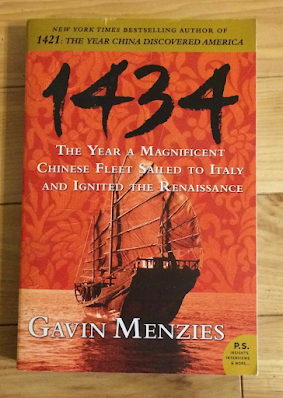Gavin Menzies was a British naval officer who wrote two books that sought to examine the Chinese influence on the world and in particular the development of Western civilization.
He was best known for his controversial book 1421: The Year China Discovered the World, in which he asserts that the fleets of Chinese Admiral Zheng He visited the Americas prior to European explorer Christopher Columbus in 1492, and that the same fleet circumnavigated the globe a century before the expedition of Ferdinand Magellan. Menzies' second book, 1434: The Year a Magnificent Chinese Fleet Sailed to Italy and Ignited the Renaissance, extended his discovery hypothesis to the European continent.
Excerpts from, "1434: The Year a Magnificent Chinese Fleet Sailed to Italy and Ignited the Renaissance" by Menzies, Page 17, (Source - Erenow):
In summary, Leonardo’s body of work rested on a vast foundation of work previously done by others. His mechanical drawings of flour and roller mills, water mills and sawmills, pile drivers, weight-transporting machines, all kinds of winders and cranes, mechanized cars, pumps, water-lifting devices, and dredgers were developments and improvements upon Francesco di Giorgio’s Trattato di architettura civile e militare. Leonardo’s rules for perspective for painting and sculpture were derived from Alberti’s De pictura and De statua. His parachute was based on di Giorgio’s. His helicopter was modeled on a Chinese toy imported to Italy circa 1440 and drawn by Taccola.31 His work on canals, locks, aqueducts, and fountains originated from his meeting in Pavia with di Giorgio in 1490 (discussed in more detail in chapter 18). His cartography evolved from Alberti’s Descriptio urbis Romae. His military machines were copies of Taccola’s and di Giorgio’s—but brilliantly drawn.
Leonardo’s three-dimensional illustrations of the components of man and machines are a unique and brilliant contribution to civilization—as are his sublime sculptures and paintings. In my eyes, he remains the greatest genius who ever lived. However, it is time to recognize the Chinese contributions to his work. Without these contributions, the history of the Renaissance would have been very different, and Leonardo almost certainly would not have developed the full range of his talents.
The first Italian hydraulic silk mill, in Verona, is described in 1456. It is a Chinese machine. John Hobson in The Eastern Origins of Western Civilisation summarizes the spread of Italian silk-weaving machines to northern Europe: “The invention of the silk filatures (reeling machines) had been made in China in 1090. The Chinese machines comprised a treadle operated silk-reeling frame with a ramping board and a roller system. The Italian model resembled the Chinese right down to the smallest detail such as the lever joined to the crank. And significantly the Italian machines more or less replicated the Chinese right down to the eighteenth century.”6 As Hobson points out, the great British mills set up by John Lombe were copies of “Chinese”-designed silk mills in Italy. Lombe’s machines became the blueprint for the British cotton industry, whose products later swamped the world.. . .By the 1450s, Florence had silk and food. The Medicis had derived unprecedented riches from the silk trade and had used their wealth to fund astronomers, mathematicians, engineers, sculptors, artists, explorers, cartographers, historians, librarians, archaeologists, and geographers. The Renaissance was in full flood—thanks in part to Chinese inventions and plants—use of machines powered by wind and water, Chinese rice, mulberry trees, and silkworms.
From the website 'Facts and Details' - "Chinese Inventions That Had An Impact on The West":
The Chinese inventions of printing, gunpowder, and the mariner’s compass were brought to Europe by Arab traders during the Renaissance and Reformation. Francis Bacon (1561-1626), a leading philosopher, politician, and adviser to King James I of England, was unaware of the origins of these inventions but deeply impressed by their significance when he wrote: “It is well to observe the force and virtue and consequence of discoveries. These are to be seen nowhere more clearly than those three which were unknown to the ancients [the Greeks], and of which the origin, though recent, is obscure and inglorious; namely printing, gunpowder, and the magnet. For these three have changed the whole face and stage of things throughout the world, the first in literature, the second in warfare, the third in navigation; whence have followed innumerable changes; insomuch that no empire, no sect, no star, seems to have exerted greater power and influence in human affairs than these three mechanical discoveries.” [Source: Asia for Educators, Columbia University, Consultants Patricia Ebrey and Conrad Schirokauer afe.easia.columbia.edu/song /=/]
Video Title: Who Started the Italian Renaissance? Source: Middle Land. Date Published: August 9, 2020. Description:
Uncovered interview of Gavin Menzies in 2008, revealing the broad journey of Ancient Chinese in spreading its technology and civilization to Europe, particularly to Italian
